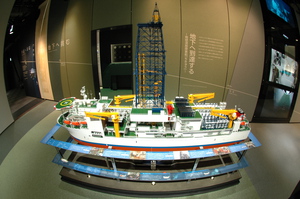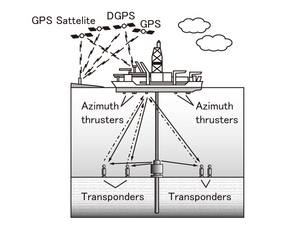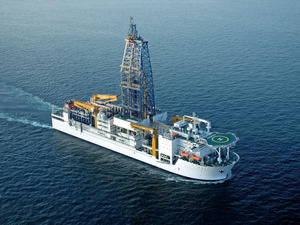Nagoya City Science Museum
TOP > Exhibition Guide > Floor Map> The drilling vessel "Chikyu"
The drilling vessel "Chikyu"



Purpose of Exhibition
It is often said that knowing what goes on underground is far more difficult than knowing the moon. The only way for direct observation of substances in the earth's deep interior is digging. We would like to introduce to you the excavating technique used for deep underground exploration.
Additional Knowledge
[What is "Boring?]
"Boring" is the process of burrowing through earth by drilling a hole deep underground. It is a useful way to directly observe substances in the deep underground and also an essential technique for digging out hot springs and oils. The deepest hole dug by human beings was the depth of 12262 km in Kola Peninsula, in the northern part of Russia. It was a boring hole for academic investigation.
The subsurface materials are shaved by rotating a steel pipe (drill pipe) which attached a hollow drill bit at the lower end, and come into the drill pipe. The collected subsurface material is a "boring-core".
[Technique of Boring ~the Drill Bit and Drilling Fluid (Drilling Mud)]
The drill bit is changed depending on the excavation of stratums and rocks. In case of soft stratums, the blade edge of iron steel is enough. On the other hand, in case of the hard rock stratum, the iron steel which tungsten-carbide or diamond are embedded in is used to resist the friction and high heat which is generated from the excavation. The selection of the drill bit affects the time and cost of excavation. Therefore, careful choosing by checking the geological condition is required.
The cutting scrap (cuttings) come out when the rocks are dug. Because of this, the cuttings need to be drawn up to the ground for digging much deeper. Moreover, you need to excavate a slightly bigger hole than the external diameter of the drill pipe, and through it between the wall of the hole and drill pipe, draw up cutting scraps to the ground with drilling fluid (drilling mud). This fluid is made by the addition of special clay; pure water is not used because the drilling fluid helps to increase the pressure in the hole and avoid the collapse of the drilled hole by the pressure of rocks. Drilling fluid also plays a role by cooling down the heated drill bit by friction. The important point is what kind of drilling fluids are chosen for boring.
[The Technique of Offshore Drilling ~Riser Drilling and DPS]
When boring is done under the seabed, drilling fluid with cuttings bursts out from the seafloor surface into the seawater. This is inefficient because a large quantity of drilling fluid is needed. Therefore, there is another way which is called "riser drilling". The other pipe is set around the drill pipe as a double pipe to collect and circulate drilling fluid to the drilling facility on the sea, and drilling fluid and cuttings go through between two pipes. The outer pipe is called the "riser pipe".
The ship is called a "drill ship" which has facilities that can bore from the sea. It is required to set the ship at the proper position to dig and drill fluid from the ship because there is the possibility of periodic currents, wind and waves on the sea. Therefore, "Dynamic Positioning System (DPS)" is adopted to keep the position of the ship automatically by using a GPS or other location sensor.
Likewise, the high technique is required to dig a few thousands meters undersea.
[Deep Sea drilling Vessel (Chikyu)]
Japanese are proud of the most state-of-the-art drilling vessel in the world, named "Chikyu". It enables us to do riser drilling with the help of its instruments, "Dynamic Positioning System (DPS)". The destination is a depth of 4,000 meters under the seabed, 7,000 meters deep underground and 11,000 meters from the ocean surface. If it dug the ocean crust, it could reach the mantle for the first time in the world. The Chikyu is the main vessel ship of "Integrated Ocean Drilling Program (IODP)" being utilized to reveal the mechanism of giant earthquakes, global-scale environmental changes for the future, origin of life, and clarification of undersea resources by digging substances in deep underground as a boring core. Scientists all over the world work in collaboration with the research and development. As it were, it is the "International Space Station" for the investigation of the earth's underground.
Cooperation:
Japan Agency for Marine-Earth Science and Technology (JAMSTEC)Article by Shoji Nishimoto, curator
